Abstract
The development of cost-effective methods, which generate minimal chemical wastewater, for methanol production is an important research goal. In this study, treated wastewater (TWW) was utilized as a culture solution for methanol production by mixed methanotroph species as an alternative to media prepared from commercial or chemical agents, e.g., nitrate mineral salts medium. Furthermore, a realistic alternative for producing methanol in wastewater treatment plants using biogas from anaerobic digestion was proposed. By culturing mixed methanotroph species with nitrate and phosphate-supplemented TWW in municipal wastewater treatment plants, this study demonstrates, for the first time, the application of biogas generated from the sludge digester of municipal wastewater treatment plants. NaCl alone inhibited methanol dehydrogenase and the addition of 40 mM formate as an electron donor increased methanol production to 6.35 mM. These results confirmed that this practical energy production method could enable cost-effective methanol production. As such, methanol produced in wastewater treatment plants can be used as an eco-friendly energy and carbon source for biological denitrification, which can be an alternative to reducing the expenses required for the waste water treatment process.
1. Introduction
A large amount of energy is needed to extract, convey, treat, and deliver potable water. Additionally, energy is required to collect, treat, and dispose of wastewater. In 2010, the U.S. water system consumed over 600 billion kWh, or approximately 12.6% of the nation’s energy [], of which the energy used for sewage treatment was 0.1–0.3% of the total energy consumption in the U.S. []. In Korea, which is the subject of this study, 1.02% of total energy was used in the water supply and sewerage sectors in 2014. In Seoul, the water supply accounts for 0.8% of total electric power consumption, and the sewerage system uses 0.9% []. In Korea, the Ministry of Environment has established and is implementing the “2010 Basic Energy Independence Plan for Sewage Treatment Plant” for energy independence through renewable energy production in sewage treatment plants []. Purification of methane from biogas is a typical application of renewable energy production in a wastewater treatment plant (WWTP). In some cases, renewable energy production involves hydroelectric power generation using the discharge fall head of treated wastewater, use of inflow sewage heat, and photovoltaics utilizing effective sites. This study attempted to present a novel bio-methanol production method using treated wastewater and biogas, which has not been considered in the existing sewage treatment plant-based renewable energy production.
Studies of methanol production using methanotrophs have focused on single species of type II methanotrophs (e.g., Methylosinus trichosporium OB3; OB3b; NCIB) using nitrate mineral salts medium (NMS medium) [,,,,,,,,]. However, the preparation of synthetic culture medium and the use of commercially available media are costly, and both generate chemical wastewater. Furthermore, to provide conditions under which a particular dominant species can survive, energy consumption requires high quantities of gas, the culture medium injected into the methanol production process is consumed, and further manipulation is required to prevent external pollution. Accordingly, these processes are difficult to commercialize. Moreover, to obtain high-purity methane (CH4 > 97%), purification and separation processes are necessary, which are highly expensive [,]. Previous studies have only been conducted under controlled conditions, without field applications, owing to the lack of cost-effective alternatives to these high-cost processes [].
Thus, to ensure the cost-effectiveness of methanol production using methanotrophs, it is necessary (1) to develop an inexpensive and widely available culture solution to replace expensive chemical culture media, such as NMS, which generates chemical wastewater, (2) to develop practical methods to maintain methanotroph species, and (3) to reduce the methane purification cost. To address these challenges, several recent studies have attempted to reduce costs by replacing high-purity methane with biogas. The production of 0.43 ± 0.00 g·L−1 methane has been achieved using biogas produced at a commercial anaerobic digestion facility with a high concentration of formate. Furthermore, raw biogas has been used as a carbon source for Methylosinus sporium to prepare 0.51–4.62 mM methane [] and simulated biogas mixtures have been used as carbon sources to co-culture and co-immobilize Methylomonas methanica and Methylocella tundrae, thereby producing methanol [].
However, alternatives to artificial culture solutions, such as NMS medium, have not been examined. Furthermore, few studies have evaluated methanol production using mixed methanotroph species collected and cultured in the natural environment.
In this study, a realistic approach was developed using (1) treated wastewater (TWW) from municipal sources as a methanotroph culture solution, (2) mixed methanotroph species collected and cultured in a natural environment, and (3) anaerobic digester biogas from a wastewater treatment plant to produce methanol. This approach has various advantages over previous methods, i.e., the wastewater generated during methanol production can flow into the wastewater treatment process, and the remaining biogas can be circulated into the digester system for biogas collection. Owing to the low water solubility of methane (22 mg/L at 25 °C), which is a strong greenhouse gas, the remaining methane is typically released into the atmosphere. Our approach can resolve this issue. This is the first study to use TWW for methanotroph-mediated methanol production and to simultaneously apply conditions (1), (2), and (3) described above.
2. Materials and Methods
2.1. Cultivation of Methanotrophs
Soil was collected at a depth of 15–20 cm from the upper layer in an area where methane production was predicted at a metropolitan landfill (20,749,874 m2, (N37.57, E126.62)) in Incheon, Korea, whose use had been terminated 2 years prior. Soil samples were collected at three separate points, uniformly mixed, filtered through a sieve (No. 50; 300 μm), and stored at 4 °C. To culture methanotrophs from the soil samples, NMS (modified Higgins nitrate mineral salt) medium was used [,]. The medium contained the following (per L of distilled water): KNO3 1.0 g; MgSO4·7H2O 1.0 g; CaCl2·H2O 0.2 g; 3.8% (w/v) Fe-EDTA solution 0.1 mL; 0.1% (w/v) NaMo·4H2O 0.5 mL; KH2PO4 26 g; Na2HPO4·7(H2O) 62 g. Additionally, 1 mL of trace element solution was added (per L of distilled solution: FeSO4·7H2O 500 mg; ZnSO4·7H2O 400 mg; MnCl2·7H2O 20 mg; CoCl2·6H2O 50 mg; NiCl2·6H2O 10 mg; H3BO3 (boric acid) 15 mg; EDTA 250 mg). The pH was adjusted to 6.8 using HCl. All chemical reagents were of analytical grade and were purchased from Sigma-Aldrich (St. Louis, MO, USA).
Next, 200 mL of NMS medium was added to a 350-mL conical flask, and 5 g of the soil sample prepared as described above for microbial inoculation was added. The flask was closed on the open end with a silicon stopper and a gas-tight syringe was used to add 20% (V%) methane to the upper 150 mL of the head space. The flask was then sealed with Parafilm and cultured in a rotary shaker (Lab Champion IS-971R; Champion Laboratories, Albion, IL, USA). Following 24 h of spinner culture at 250 rpm at 30 °C, the solution was left to settle for 10 min, after which 100 mL of the supernatant was removed and added to a fresh 350-mL conical flask containing NMS medium. The procedure was repeated four times, and the resulting solution containing NMS medium was finally separated using by centrifugation (Centrifuge-416; Dongseo Science, Ltd., Dangjin, Korea) at 2700× g. The centrifuged pellet was freeze-dried at −55 °C in a freeze dryer (OPERN FDS-12003; Seoul, Korea) for subsequent use.
In subsequent experiments, the lyophilized cells were inoculated into 50 mL of the cultured solution in a 160-mL serum bottle (Sigma-Aldrich, St. Louis, MO, USA) to adjust the concentration to 520 mg/L. When using purified methane gas (99.99%), the O2/CH4 content was adjusted to 18.5 mL/22.0 mL by replacing 22 mL, i.e., 20% of the head space (110 mL), with methane. The sample was then incubated in a shaking incubator at 30 °C and 150 rpm.
2.2. Treated Wastewater in the Wastewater Treatment Plant
TWW and anaerobic digestion biogas were generated at the Ilsan wastewater treatment plant in Goyang-si, South Korea. The Ilsan wastewater treatment plant is a tertiary advanced treatment facility with a treatment capacity of 270,000 m3∙day−1. TWW was used, rather than the raw sewage, as a culture solution because raw sewage has a high ammonia content. When ammonia is present during metabolic processes in methanotrophs, it competes with methane as a co-metabolic substrate of methane monooxygenase (MMO), an enzyme that mediates methane oxidation and acts as an inhibitor of methane oxidation by methanotrophs [,,]. The process of ammonia oxidation by methanotrophs is similar to the ammonia oxidation pathway of ammonia-oxidizing bacteria. Numerous studies have focused on the competitive inhibition of MMO by ammonia [,] and the effects of toxic intermediates, i.e., hydroxylamine and nitrite, produced during ammonium oxidation [].
Unlike type I methanotrophs, a high copper ion concentration is detrimental to growth and soluble methane monooxygenase (sMMO) expression in type II methanotrophs []. Thus, the concentration of copper ions is a major determinant of methanotroph growth. The copper ion concentration in the TWW of the target wastewater treatment plant in this study was in the range of 12 μM to 34 μM. The properties of the TWW used to replace NMS medium were as follows: pH 7.0, 10.2 mg·L−1 nitrate, 3.1 mg·L−1 ammonium ions, 0.2 mg·L−1 phosphate ions, 0.001 (15.7 µM) mg·L−1 Cu, 0.0021 mg·L−1 K, 0.4920 mg·L−1 Mg, 0.0232 mg·L−1 Ca, 0.0132 mg·L−1 Zn, 0.0123 mg·L−1 Mn, 0.0116 mg·L−1 Mo, 0.0092 mg·L−1 Co, 0.045 mg·L−1 Fe, 0.0024 mg·L−1 Ni. NaNO3 and KH2PO4 were used to supply nitrogen and phosphorus, which are required for methanotroph growth. The samples were stored in a refrigerator at 4 °C.
2.3. Biogas in the Wastewater Treatment Plant
The final anaerobic sludge digester biogas of the wastewater treatment plant was composed of CH4 (68.9%), CO2 (29.3%), N2 (1.1%), and O2 (0.7%) and was collected and stored in a Teflon bag. When biogas was used, 25 mL, i.e., 22.7% the 160-mL serum bottle headspace space (22.7%), was substituted with biogas to adjust the O2/CH4/CO2 content to 17.8 mL/20.7 mL/7.3 mL.
2.4. Biogas and Metabolite Measurements
For the biogas (CH4, CO2, N2, and O2) analysis, the methane content in the serum bottle headspace was measured using a gas chromatographer (HP Agilent 6890A; Santa Clara, CA, USA) equipped with a packed column (GS-GASPRO; 30 m × 0.32 mm) and flame ionization detector (FID). The conditions were an inlet temperature of 100 °C, oven temperature of 50 °C (3 min), and detector temperature of 200 °C, using He as the carrier gas and setting the flow rate to 1.2 mL min−1 with a split ratio of 20:1.
For the methanol analysis, a gas chromatographer (HP Agilent 6890A; head space G1888, Santa Clara, CA, USA) equipped with a packed column (INNOWAX 30 m × 0.25 mm × 0.25 μm) and an FID was used. The conditions were an oven temperature of 50 °C (5 min), which was raised to 250 °C (3 min), and a detector temperature of 250 °C, using N2 as the carrier gas and setting the flow rate to 1.2 mL min−1 with a split ratio of 10:1.
For the formaldehyde analysis, high-performance liquid chromatography (HPLC; Agilent 1100 series, Santa Clara, CA, USA) with a column (Eclipse XDB-C18; 5 µm, 4.6 × 150 mm) was used. The mobile phases were mobile A (D.W 100%) and mobile B (ACN 100%), with a mobile flow of 1.5 mL/min, eluent A:B of 50:50, runtime of 38 min, and detection wavelength of 360 nm.
For the formate analysis, HPLC (Agilent 1100 series, Santa Clara, CA, USA) equipped with a column (Agilent Hi-Plex H; 8 µm, 7.7 × 300 mm) was used. The injection volume was 20 µL and the mobile phase was 100% 0.01 M H2SO4, with a mobile phase flow rate of 0.6 mL min−1, eluent of 100% 0.01 M H2SO4, runtime of 60 min, and detection wavelength of 210 nm.
2.5. Enzyme Assays
The naphthalene oxidation assay was conducted to quantify the specific activity of sMMO []. This method allows specific activity to be measured under the assumption that only sMMO of methanotrophs can convert naphthalene into 1- or 2-naphthol by oxidation. The 1- or 2-naphthol generated during oxidation can react with tetrazotized O-dianisidine to form a purple naphthol diazo compound, whose UV absorbance was measured at A530 nm using a UV-visible spectrophotometer (UV-1600; Shimadzu, Kyoto, Japan) as follows. (1) Cell suspensions were transferred in 1-mL aliquots to 10-mL screwcap test-tubes. (2) Next, 1 mL of saturated naphthalene solution was added to each sample. (3) The reaction mixtures were incubated on a rotary shaker at 30 °C for 1 h. (4) After incubation, 100 µL of freshly prepared 0.2% (w/v) tetrazotized O-dianisidine solution was added to the reaction mixture. (5) Samples were immediately monitored spectrophotometrically at 525 nm. (6) sMMO is expressed in nanomoles naphthol formed per milligram of cell protein per hour.
Methanol dehydrogenase (MDH) activity was estimated by measuring changes in the UV absorbance of the phenazine methosulfate compound induced by the reduction of 2,6-dichlorophenol-indophenol (DCPIP) at 600 nm using a UV-visible spectrophotometer (UV-1600; Shimadzu, Kyoto, Japan). The assay solution contained CaCl2 (10 mM), NH4Cl (45 mM), phosphate buffer (0.3 M, pH 7.5), the whole cell supernatant (DCM 5 mg), DCPIP (0.13 µM), and phenazine methosulfate (3.3 µM) in a 1-mL reaction solution [,]. NaCl, which is the cheapest and most effective MDH inhibitor, was used [,,].
All experimental data are presented as the means and standard deviation of the results of three sets of independent experiments.
2.6. Microbial Community Analysis
For the microbiological analysis, DNA extraction, PCR amplification, and pyrosequencing were performed by ChunLab, Inc. (Seoul, Korea). The 16S rRNA genes for each sample were amplified using barcoded universal primers. PCR was performed under the following cycling conditions: An initial denaturation step at 94 °C for 300 s, followed by 10 cycles of denaturation at 94 °C for 30 s, annealing at 60 °C to 55 °C (−0.5 °C/cycle, with a touchdown program) for 45 s, and extension at 72 °C for 90 s. This was followed by an additional 20 cycles of denaturation at 94 °C for 30 s, annealing at 55 °C for 45 s, and elongation at 72 °C for 90 s, and a final elongation step at 72 °C for 5 min.
The composition and ratio of microbial species shared by the three sets of samples were calculated.
2.7. Water Quality Analysis
Analyses of water quality and components of TWW were based on the American Standard Methods for the Examination of Water and Wastewater (23rd ed., American Public Health Association) and EPA Methods (EPA Method 1613). Organic components were analyzed by the colorimetric method, and the atomic analysis was performed by atomic-absorption-spectroscopy.
2.8. Statistical Analysis
Statistical significance was determined by repeated measures ANOVA (α = 0.05) using SPSS Statistical Software (IBM SPSS 22.0; Cary, NC, USA). Experimental data are presented as means ± standard error.
3. Results and Discussion
3.1. Analysis of Cultured Methanotrophs
Figure 1 shows the composition and number of species based on PCR assays of bacteria cultured on the NMS medium. The cultured methanotrophs included Methylomonas, Methylococcus, Methylobacter, Methylosarcina, and Methylomonas_f_uc. The dominant species were Methylomonas methanica, Methylococcus capsulatus, Methylococcus bovis, and Methylobacter marinus. Methylomonas is mainly found in sediments of lakes, ponds, or freshwater areas [] Methylococcus includes typical type I or type X methanotrophs []. Methylobacter is adapted to a wide range of NaCl conditions (approximately 100 mM) according to Bowman et al. [], and exhibits optimal growth at 37 °C as well as a stable activity with respect to changes in oxygen [,]. Table 1 shows the ICM (intracytoplasmic membrane) type and MMO (sMMO or pMMO) type of the major taxa detected in the analysis. All of the type I methanotrophs, except for Methylococcus bovis, expressed sMMO and pMMO simultaneously.
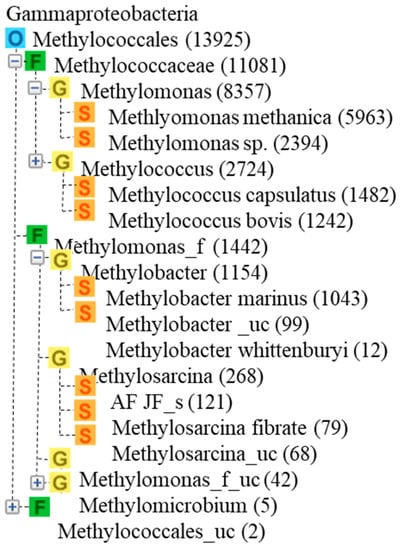
Figure 1.
Composition of methanotroph species (output from CL community (ChunLab Inc.) cultured in NMS medium. The numbers in parentheses indicate the number of bacteria belonging to the particular species in the samples.

Table 1.
ICM (intracytoplasmic membrane) types and MMO (sMMO, pMMO) types for major species.
The MMO type and growth rates of methanotrophs depend on the copper (Cu2+) concentration. In the case of Methylomonas methanica strain 68-1, MMO has been detected in the form of pMMO, rather than sMMO, for a Cu2+ concentration of 1 µM or greater []. Previous studies of Methylococcus capsulatus Bath have shown increases in cell mass, the abundance of intracytoplasmic membranes, and pMMO in growth medium with a copper concentration of 5–10 µM. Methylococcus capsulatus Bath exhibits minimal growth when it is cultured without copper in the growth medium [,].
Methylobacter marinus expresses both pMMO and sMMO, as a type I methanotroph [], and Methylococcus capsulatus Bath simultaneously expresses pMMO and sMMO as a type X methanotroph []. Moreover, the expression patterns of sMMO and pMMO vary according to the concentration of copper ions [,], and the conversion of sMMO into pMMO occurs at a copper ion concentration of 10 mM or greater []. The growth rate of Methylococcus capsulatus strain M is greater at 40 mM than at lower or higher copper concentrations [].
3.2. Consumption of Nitrate and Phosphate by Methanotrophs
Methanotrophs require relatively high quantities of nitrogen and phosphorus for growth. Anthony (1982) confirmed that methanotrophs consume 0.25 mol of nitrogen to assimilate 1 mole of carbon from methane [].
To evaluate nitrate and phosphate consumption in this study, mixed methanotroph species were cultivated in NMS. The consumption levels were 275.0 mg·L−1 nitrate and 147.7 mg·L−1 phosphate (Figure 2). Based on these results, NaNO3 and KH2PO4 were added to the TWW to adjust the concentrations of nitrate and phosphate to 300 mg·L−1 and 160 mg·L−1, respectively, for use as the methanotroph culture solution in subsequent experiments.
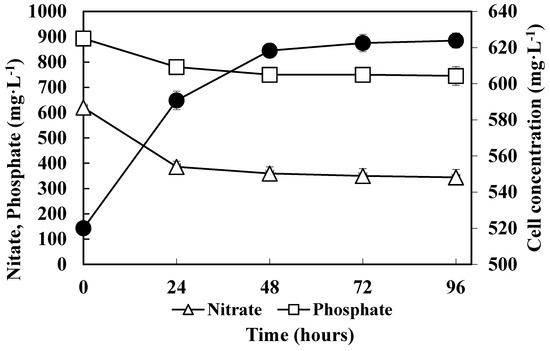
Figure 2.
Nitrate and phosphate consumption by mixed methanotroph species during growth on NMS medium.
3.3. Comparison of the Methanotroph Growth Rate and Methane Absorption Rate Using Different Culture Solutions
Figure 3 shows a comparison of the methanotroph-specific growth rate (a) and methane uptake rate (b) in NMS medium and TWW supplemented with nitrate and phosphate in TWW. The specific growth rate (Figure 3a) and methane uptake (Figure 3b) of mixed methanotroph species did not differ between the NMS medium and the enriched TWW (p > 0.05). These results confirmed that TWW supplemented with nitrogen and phosphate was suitable for use as a methanotroph culture solution.
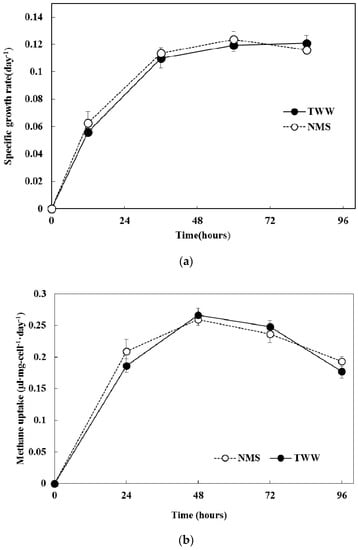
Figure 3.
Comparison of the methanotroph-specific growth rate (a) and methane uptake rate (b) in NMS medium and TWW supplemented with nitrate and phosphate.
Methanol production by mixed methanotroph species was similar using NMS medium and pretreated TWW with biogas (Figure 4), e.g., the concentrations were 3.60 ± 0.21 mM using NMS medium and 3.50 ± 0.20 mM using TWW after 48 h. The initially lower methanol production in TWW than in NMS medium could be explained by the partial consumption of MMO by a trace amount of ammonium (3.1 mg·L−1) remaining in the TWW.
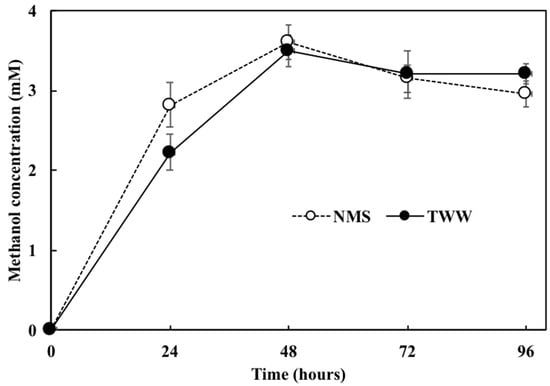
Figure 4.
Changes in methanol production in NMS medium and TWW supplemented with nitrate and phosphate.
3.4. Effect of NaCl as an MDH Inhibitor, Including Analysis of Methane Uptake and Methanol Production
It is necessary to inhibit MDH activity to prevent the oxidation of the produced methanol. EDTA, cyclopropane, cyclopropanol, dithiothreitol, phenylhydrazine, NaCl, iodoacetate, MgCl2, NH4Cl, and a high concentration of phosphate have been applied to prevent the conversion of methanol to formaldehyde by inhibiting MDH activity. For example, chelating agents, such as EDTA, significantly inhibit the activity of methanol oxides and MDH []. Among these materials, NaCl is the most inexpensive and widely available MDH inhibitor [,,,,,].
Methylosinus trichosporium OB3b was used in the presence of NaCl 200 mM, 12.9 mM phosphate (pH 7), and 20 mM sodium formate (at 25 °C for 36 h in NMS medium, methane/air (1:4 (v/v))) to produce 7.7 mM methanol []. Methylosinus trichosporium OB3b in the presence of 100 mM NaCl and 1 mM EDTA as MDH inhibitors and 20 mM sodium formate with 10 mM phosphate buffer (pH 7.0) (at 25 °C for 12 h in NMS medium methane/air (1:1 (v/v), 5 µM CuSO4)) yields 13.2 mM methanol [].
The inhibitory effects of NaCl alone, without other MDH inhibitors, such as EDTA and a high concentration of phosphate buffer, on MDH were evaluated. In particular, the effects of NaCl concentration on sMMO expression and MDH activity were analyzed (Figure 5). sMMO expression gradually decreased and as the NaCl concentration increased to 40 mM. MDH activity gradually decreased to 84% for NaCl concentrations of up to 40 mM and then sharply decreased to 42% for concentrations of up to 60 mM (Figure 5a).
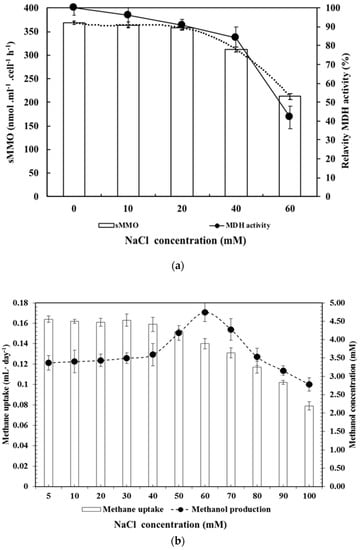
Figure 5.
Changes in sMMO expression and MDH activity (a) and methane uptake rate and methanol production with respect to NaCl concentration (b) in treated wastewater medium.
The MDH inhibitory effect was consistent with previous results indicating that the optimal concentration of NaCl for MDH inhibition using the type II methanotroph Methylocystis bryophila is 50 mM []. For mixed methanotroph species cultured on enriched TWW medium, changes in methane consumption and methanol production were compared according to the concentration of NaCl as an MDH inhibitor (Figure 5b). The maximum methanol production by mixed methanotroph species was 4.74 mM at an NaCl concentration of 60 mM.
3.5. Effect of Formate
In some studies, approximately 2 mM formate, formic acid, ascorbic acid, or citric acid has been used to maintain the high activity of MMO [], and sodium formate has been used as a reductant to induce sMMO activity []. These studies are based on the assumption that reversible enzymatic reactions can occur. In this study, sodium formate was injected to supply formate, which is the final product of methane oxidation, and changes in methanol production were observed. The maximum methanol production of 6.35 mM was detected using 60 mM NaCl and 40 mM formate (Figure 6). In this case, the concentration of sMMO increased from 445 nmol mL−1 cell−1 h−1 to 595 nmol mL−1 cell−1 h−1 by the injection of 40 mM formate.
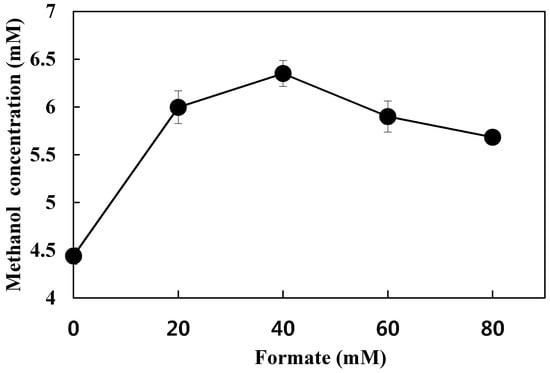
Figure 6.
Effect of formate concentration on methanol production from biogas and NaCl (60 mM) in treated wastewater medium.
Changes in metabolites were evaluated with respect to MDH inhibition (Table 2).

Table 2.
Concentrations of methanotroph metabolites (methanol, formaldehyde, and formate) in NMS medium according to the NaCl concentration (1) and comparison of methanol production among studies using NaCl as an MDH inhibitor (2).
The methanol component was 54.9% (3.46 mM) in TWW supplemented with nitrate and phosphate (control), and 82.7% (4.52 mM) using 60 mM NaCl. The total amount of whole metabolites (methanol, formaldehyde, and formate) was 6.3 mM, which was greater than that in the control (without NaCl as an MDH inhibitor). Although the addition of an inhibitor of MDH increases methanol production, it also induces the inhibition of methanotroph activity, and the degree of inhibition can be indirectly determined by total metabolite concentration.
In comparison with methanol production (2.21–13.2 mM) observed using NaCl as an MDH inhibitor in NMS medium for single species using purified methane [,,,], TTW (tertiary treatment) supplemented with nitrate and phosphate, biogas generated from the digester, and mixed methanotrophs resulted in 6.35 mM methanol. These results confirmed that the use of TWW as a culture solution for methanotrophs could be a cost-effective approach for methanol production.
4. Conclusions
This study is the first to propose a bio-methanol production method as a renewable energy using treated wastewater and biogas generated from a sewage treatment plant. Mixed methanotroph species were cultivated with nitrate and phosphate in a municipal wastewater treatment plant using biogas generated from the sludge digester. Methanol production of 4.52 mM was achieved using only NaCl as an MDH inhibitor. The addition of 40 mM formate increased MMO activity, yielding 6.35 mM methanol. These results confirmed that biogas as well as TWW generated from the wastewater treatment plant can be used for cost-effective methanol production, without additional contamination by wastewater and waste biogas in the wastewater treatment plant.
Author Contributions
Conceptualization, I.-T.K. and Y.-S.Y.; Validation, I.-T.K., Y.-H.Y., J.-H.J., Y.-S.Y.; Formal Analysis, I.-T.K. and K.-S.K.; Investigation, I.-T.K.; Resources, I.-T.K., Y.-H.Y. and W.J.; Writing—Original Draft Preparation, I.-T.K.; Writing—Review & Editing, Y.-E.L., I.-T.K., Y.-S.Y. and I.-T.K.; Supervision, I.-T.K., Y.-S.Y.; Project Administration, I.-T.K.
Funding
This study was conducted as part of the “Development of food waste desalination and alternative renewable energy production plant technology” (project number 20180063-0001), the main organizational project by the Korea Institute of Civil Engineering and Building Technology, Andong, South Korea (KICT).
Acknowledgments
We would like to thank Editage (www.editage.co.kr) for English language editing.
Conflicts of Interest
The authors declare no conflict of interest.
References
- NCSL (National Conference of State Legislatures). Overview of the Water-Energy Nexus in the United States. 2014. Available online: http://goo.gl/2pFxgQ (accessed on 3 October 2018).
- Stillwell, A.S.; Hoppock, D.C.; Webber, M.E. Energy Recovery from Wastewater Treatment Plants in the United States: A Case Study of the Energy-Water Nexus. Sustainability 2010, 2, 945–962. [Google Scholar] [CrossRef]
- Choi, Y.J. Urban Waste Water Treatment, Move beyond Sewage Treatment to Energy Production Bases; Water Regeneration Center, Seoul’s Top Policy Package: Seoul, Korea, 2015; pp. 1–26. [Google Scholar]
- Basic Energy Independence Plan for Sewage Treatment Plant; Ministry of Environment: Seoul, Korea, 2010.
- Chan, H.T.C.; Anthony, C. The mechanism of inhibition by EDTA and EGTA of methanol oxidation by methyltrophic bacteria. FEMS Microbiol. Lett. 1992, 96, 231–234. [Google Scholar] [CrossRef]
- Duan, C.; Luo, M.; Xing, X. High-rate conversion of methane to methanol by Methylosinus trichosporium OB3b. Bioresour. Technol. 2011, 102, 7349–7353. [Google Scholar] [CrossRef] [PubMed]
- Han, J.S.; Ahn, C.M.; Mahanty, B.; Kim, C.G. Partial oxidative conversion of methane to methanol through selective inhibition of methanol dehydrogenase in methanotrophic consortium from landfill cover soil. Appl. Biochem. Biotechnol. 2013, 171, 1487–1499. [Google Scholar] [CrossRef] [PubMed]
- Hwang, I.Y.; Lee, S.H.; Choi, Y.S.; Park, S.J.; Na, J.G.; Chang, I.S.; Kim, C.K.; Kim, H.C.; Kim, Y.H.; Lee, J.W.; et al. Biocatalytic conversion of methane to methanol as a key step for development of methane-based biorefineries. J. Microbiol. Biotechnol. 2014, 24, 1597–1605. [Google Scholar] [CrossRef] [PubMed]
- Kim, H.G.; Han, G.H.; Kim, S.W. Optimization of lab scale methanol production by Methylosinus trichosporium OB3b. Biotechnol. Bioprocess Eng. 2010, 15, 476–480. [Google Scholar] [CrossRef]
- Mardina, P.; Li, J.; Patel, S.K.S.; Kim, I.W.; Lee, J.K.; Selvara, C. Potential of immobilized whole-cell Methylocella tundrae as a biocatalyst for methanol production from methane. J. Microbiol. Biotechnol. 2016, 26, 1234–1241. [Google Scholar] [CrossRef] [PubMed]
- Patel, S.K.; Mardina, P.; Kim, S.Y.; Lee, J.K.; Kim, I.W. Biological methanol production by a Type II methanotroph Methylocystis bryophila. J. Microbiol. Biotechnol. 2016, 26, 717–724. [Google Scholar] [CrossRef] [PubMed]
- Yoo, Y.S.; Han, J.S.; Ahn, C.M.; Min, D.H.; Mo, W.J.; Yoon, S.U.; Lee, J.G.; Lee, J.Y.; Kim, C.G. Characteristics of methanol production derived from methane oxidation by inhibiting methanol dehydrogenase. J. Korea Soc. Environ. Eng. 2011, 33, 662–669. [Google Scholar] [CrossRef]
- Higgins, I.J.; Best, D.J.; Hammond, R.C.; Scott, D. Methane-oxidizing microorganisms. Microbiol. Rev. 1981, 45, 556–590. [Google Scholar] [PubMed]
- Sheets, J.P.; Ge, X.; Li, Y.F.; Yu, Z.; Li, Y. Biological conversion of biogas to methanol using methanotrophs isolated from solid-state anaerobic digestate. Bioresour. Technol. 2016, 201, 50–57. [Google Scholar] [CrossRef] [PubMed]
- Patal, S.K.S.; Jeong, J.H.; Mehariya, S.; Sachin, V.; Otari, S.V.; Madan, B.; Hwa, J.R. Production of Methanol from Methane by Encapsulated Methylosinus sporium. J. Microbiol. Biotechnol. 2016, 26, 2098–2105. [Google Scholar] [CrossRef] [PubMed]
- Patel, S.K.S.; Kumar, V.; Mardina, P.; Li, J.; Lestari, R.; Kalia, V.C.; Lee, J.K. Methanol production from simulated biogas mixtures by co-immobilized Methylomonas methanica and Methylocella tundrae. Bioresour Technol. 2018, 263, 25–32. [Google Scholar] [CrossRef] [PubMed]
- Hoefman, S.; Ha, D.; van der Boon, N.; Vandamme, P.; Vos, P.D.; Kim, H. Niche differentiation in nitrogen metabolism among methanotrophs within an operational taxonomic unit. BMC Microbiol. 2014, 14, 83. [Google Scholar] [CrossRef] [PubMed]
- Bedard, C.; Knowles, R. Physiology, biochemistry, and specific inhibitors of CH4, NH4+, and CO oxidation by methanotrophs and nitrifiers. Microbiol. Rev. 1989, 53, 68–84. [Google Scholar] [PubMed]
- Calsen, H.N.; Joergensen, L.; Degn, H. Inhibition by ammonia of methane utilization in Methylococcus capsulatus (Bath). Appl. Microbiol. Biotechnol. 1991, 35, 124–127. [Google Scholar]
- Bradford, M.A.; Ineson, P.; Wookey, P.A.; Lappin-Scott, H.M. The effects of acid nitrogen and acid sulphur deposition on CH4 oxidation in a forest soil: A laboratory study. Soil Biol. Biochem. 2001, 33, 1695–1702. [Google Scholar] [CrossRef]
- Wang, Z.P.; Ineson, P. Methane oxidation in a temperate coniferous forest soil: Effects of inorganic N. Soil Biol. Biochem. 2003, 35, 427–433. [Google Scholar] [CrossRef]
- Schnell, S.; King, G.M. Mechanistic analysis of ammonium inhibition of atmospheric methane consumption in forest soil. Appl. Environ. Microbiol. 1994, 60, 3514–3521. [Google Scholar] [PubMed]
- Semrau, J.D.; DiSpirito, A.A.; Yoon, S. Methanotrophs and copper. FEMS Microbiol. Rev. 2010, 34, 496–531. [Google Scholar] [CrossRef] [PubMed]
- Brusseau, G.A.; Tsien, H.C.; Hanson, R.S.; Wackett, L.P. Optimization of trichloroethylene oxidation by methanotrophs and the use of a colorimetric assay to detect soluble methane monooxygenase activity. Biodegradation 1990, 1, 19–29. [Google Scholar] [CrossRef] [PubMed]
- Kalyuzhnaya, M.G.; Hristova, K.R.; Lidstrom, M.E.; Chistoserdova, L. Characterization of a novel methanol dehydrogenase in representatives of Burkholderiales: Implications for environmental detection of methylotrophy and evidence for convergent evolution. J. Bacteriol. 2008, 190, 3817–3823. [Google Scholar] [CrossRef] [PubMed]
- Madigan, M.T.; Martino, J.M. Brock Biology of Microorganisms, 11th ed.; Pearson: London, UK, 2006; p. 136. [Google Scholar]
- Takeuchi, M.; Kamagata, Y.; Oshima, K.; Hanada, S.; Tamaki, H.; Marumo, K.; Maeda, H.; Nedachi, M.; Hattori, M.; Iwasaki, W.; et al. Methylocaldum marinum sp. nov., a novel thermotolerant methane oxidizing bacterium isolated from marine sediments. Int. J. Syst. Evol. Microbiol. 2014, 64, 3240–3246. [Google Scholar] [CrossRef] [PubMed]
- Bowman, J.; Sly, L.; Cox, J.; Nichols, P.; Hayward, A.C. Revised taxonomy of the methanotrophs: Description of Methylobacter gen. nov., emendation of Methylococcus, validation of Methylosinus and Methylocystis species, and a proposal that the family Methylococcaceae includes only the group I methanotrophs. Int. J. Syst. Bacteriol. 1993, 43, 735–753. [Google Scholar] [CrossRef]
- Oshkin, I.; Beck, D.A.C.B.; Lamb, A.E.; Tchesnokova, V.; Benuska, G.; McTaggart, T.L.; Kalyuzhnaya, M.G.; Dedysh, S.; Lidstrom, M.E.; Chistoserdova, L. Methane fed microcosms show differential community dynamics and pinpoint specific taxa involved in communal response. ISME J. 2014, 9, 1119–1129. [Google Scholar] [CrossRef] [PubMed]
- Whittenbury, R.; Phillips, K.C.; Wilkinson, J.F. Enrichment, isolation and some properties of methane-utilizing bacteria. J. Gen. Microbiol. 1970, 61, 205–218. [Google Scholar] [CrossRef] [PubMed]
- Koh, S.C.; Bowman, J.P.; Sayler, G.S. Soluble methane monooxygenase production and trichloroethylene degradation by a type I methanotroph, Methylomonas methanica 68-1. Appl. Environ. Microbiol. 1993, 59, 960–967. [Google Scholar] [PubMed]
- Collins, M.L.; Buchholz, L.A.; Remsen, C.C. Effect of copper on Methylomonas albus BG8. Appl. Environ. Microbiol. 1991, 57, 1261–1264. [Google Scholar] [PubMed]
- Lemos, S.S.; Perille Collins, M.L.; Eaton, S.S.; Eaton, G.R.; Antholine, W.E. Comparison of EPR-visible Cu (2+) sites in pMMO from Methylococcus capsulatus (Bath) and Methylomicrobium album BG8. Biophys. J. 2000, 79, 1085–1094. [Google Scholar] [CrossRef]
- Lidstrom, M.E. Isolation and characterization of marine methanotrophs. Antonie Van Leeuwenhoek 1988, 54, 189–199. [Google Scholar] [CrossRef] [PubMed]
- Ashraf, Y.Z. Khalifa, Mutagenesis of a Copper P-Type ATPase Encoding Gene in Methylococcus capsulatus (Bath) Results in Copper-Resistance. Int. J. Biosci. Biochem. Bioinform. 2013, 3, 37–42. [Google Scholar]
- Khalifa, A.Y.Z. Physiological features during the copper switch in Methylococcus capsulatus (Bath). Int. J. Biosci. Biochem. Bioinform. 2013, 3, 63–66. [Google Scholar] [CrossRef]
- Madigan, M.T.; Martnko, J.M.; Parker, J. Biology of Microorganisms, 8th ed.; Simon & Schuster: New York, NY, USA, 1997. [Google Scholar]
- Avdeeva, L.; Gvozdev, R. Effect of copper concentration on the growth of Methylococcus capsulatus (Strain M). Chem. J. Mold. 2017, 12, 110–114. [Google Scholar] [CrossRef]
- Anthony, C. The Biochemistry of Methylotrophs; Academic Press Ltd.: London, UK, 1982. [Google Scholar]
- Xin, J.Y.; Cui, J.R.; Niu, J.Z.; Hua, S.F.; Xia, C.G.; Li, S.B.; Zhu, L.M. Production of methanol from methane by methanotrophic bacteria. Biocatal. Biotransform. 2004, 22, 225–229. [Google Scholar] [CrossRef]
- Yoo, Y.S.; Han, J.S.; Ahn, C.M.; Kim, C.G. Comparative enzyme inhibitive methanol production by Methylosinus sporium from simulated biogas. J. Environ. Technol. 2015, 36, 983–991. [Google Scholar] [CrossRef] [PubMed]
- Lee, S.G.; Goo, J.H.; Kim, H.G.; Oh, J.L.; Kim, Y.M.; Kim, S.W. Optimization of methanol biosynthesis from methane using Methylosinus trichosporium OB3b. Biotechnol. Lett. 2004, 26, 947–950. [Google Scholar] [CrossRef] [PubMed]
- Kim, H.G.; Kim, S.W. Purification and characterization of a methanol dehydrogenase derived from Methylomicrobium sp. HG-1 cultivated using a compulsory circulation diffusion system. Biotechnol. Bioprocess Eng. 2006, 11, 134–139. [Google Scholar] [CrossRef]
- Palumbo, A.V.; Strong-Gunderson, M.; Carroll, S. Retaining and recovering enzyme activity during degradation of TCE by methanotrophs. Appl. Biochem. Biotechnol. 1997, 63–65, 789–796. [Google Scholar] [CrossRef] [PubMed]
- McDonald, I.R.; Miguez, C.B.; Rogge, G.; Bourque, D.; Wendlandt, K.D.; Groleau, D.; Murrell, J.C. Diversity of soluble methane monooxygenase-containing methanotrophs isolated from polluted environments. Microbiol. Lett. 2006, 255, 225–232. [Google Scholar] [CrossRef] [PubMed]
© 2018 by the authors. Licensee MDPI, Basel, Switzerland. This article is an open access article distributed under the terms and conditions of the Creative Commons Attribution (CC BY) license (http://creativecommons.org/licenses/by/4.0/).